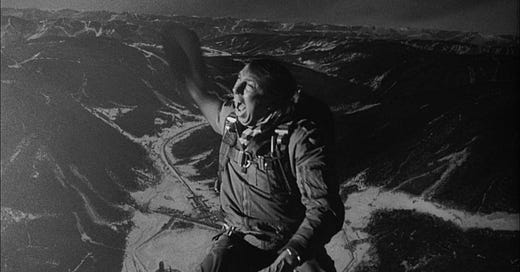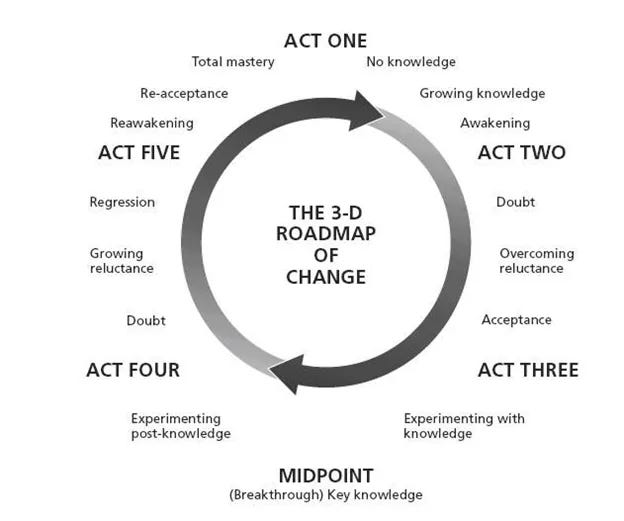Mapping “Dr. Strangelove” to Yorke’s Roadmap
Or: How I learned to stop worrying and love the structure
We looked at Branching Narrative in the last post and expanding on that, let’s take a look at Structure.
Many creative writing courses discuss story structure and its importance. John Yorke’s “Into The Woods” often ends on the required reading list. For me, it was a good refresher and recaps what many others have said before, all the way back to the Greeks, in an easy, accessible way.
For this particular exercise, we are looking at screenplays and how Yorke’s 3-D Roadmap of Change (see below) can apply there. Take any movie. In all likelihood, you can find the structural elements as depicted in Yorke’s map (or any other model you may choose). Is that so? Charlie Kaufman may disagree. Then again, even “Adaptation” – as Robert McKee may tell you – fits perfectly into a three-act or five-act structure. Go on, you’ll see.
How can we map “Dr. Strangelove or: How I Learned to Stop Worrying and Love the Bomb” (1964) to this structure?
If you haven't seen the movie, I highly recommend you do. I might add that it has never been more topical than it is in today’s geopolitical landscape. Stop reading now, watch the movie, then come back and discuss, or read on if you don't mind getting all the spoilers.
The film, directed by Stanley Kubrick and starring Peter Sellers in three roles, is considered a masterpiece. It is remarkably fresh and undated. It is a satirical black comedy about the Cold War fears of a nuclear conflict between two sovereign nations: the Soviet Union and the United States.
The New Yorker wrote this about it: Almost Everything in “Dr. Strangelove” Was True
The movie script is available here for educational purposes: Jan 27, 1963 revision, final version.
NB: The final version of the script is a transcript and hence only has 55 pages. For the sake of this exercise, the scan of the 1963 version was used since it retains the original formatting, albeit it has undergone substantial changes in its final version.
Finished watching the movie? Then, let’s dive right into the structural recap.
Dr. Strangelove's Roadmap of Change
Act 1
No knowledge
VO about the secret Doomsday device developed by the Soviets.
Inciting Incident (00:05 min)
General Jack Ripper, gone insane, orders Plan R, a nuclear strike on Soviet Russia, commanding Officer Mandrake (Sellers) to execute said plan.
Growing knowledge
B52 Pilot Major King Kong (Slim Pickens) receives the Plan R code and verifies General Turgidson gets the phone call about Plan R. Officer Mandrake suspects General Ripper has gone crazy.
Awakening (00:19 min)
Mandrake finds a radio. General Turgidson briefs the President in the War Room.
Act 2 (00:20 min)
Doubt
Mandrake listens to the radio playing music, indicating no Soviet attack. Russian Ambassador Alexi is invited to the War Room, and together they contact Premier Dimitri.
“… well, he went a little funny in the head. You know. Just a little… funny. And, uh, he went and did a silly thing.”
Acceptance
Initial reluctance but eventual acceptance of what needs to be done since they can’t recall the planes. Work together to shoot them down. President: “I’ll accept that.”
Act 3 (00:45 min)
Experiment with knowledge
Go all in, nuke the Soviets completely, and hope to minimize losses on the US side. No. Try to reach mad General, sending in troops to take the base and contact Premier Dimitri with help of Ambassador Alexi.
Midpoint
DOOMSDAY DEVICE revealed.
Experimenting with knowledge
The base is attacked and taken. General Ripper rants about a Commie plot “Fluoridation” of water and starts shooting back with MG from inside his office.
Experimenting post-knowledge
Ripper: “I deny them my essence” / shoots himself. Mandrake needs to find the recall code on his own.
Act 4 (01:01 min)
Doubt
Mandrake tries to figure out the recall code, hindered by Col. ‘Bat’ Guano. Meanwhile, the plane is damaged by a missile but not shot down, bomb doors won't open.
Growing Reluctance
The pilot tries everything to open bomb doors, and Mandrake tries to phone the White House to give OPE recall code (phone booth scene, doesn’t have the coins…)
Regression
All planes were recalled, four were shot down by Soviet missiles, and the crisis was averted.
Act 5 (01:14 min)
Reawakening
One plane was not shot down! (The B52, piloted by Kong); Plane crew faces accelerated fuel loss.
Re-acceptance
With the remaining plane only damaged, the President (Sellers) convinces Premier Dimitri that they need to shoot down the rogue plane, the plane crew chooses a new target of opportunity due to the rate of loss of fuel.
Total mastery (01:27 min)
Major Kong manages to open the damaged doors and rides the bomb in this iconic scene.
YEE-HAW!
BOOOOOOOM
As advised by Nazi scientist Dr. Strangelove (Sellers), the Americans decide to go down to the mines for 100 years. However, mind the “mine gap” (missile gap reference), “Russkies” may take over their mine shaft space…
Moral
Mankind has learned nothing.
Consequence
(01:34 min) The Doomsday device goes off, followed by a multitude of nuclear explosions to the iconic WWII song “We’ll Meet Again” by Vera Lynn (1943).
The End.
Disclaimer: This mapping to the Yorke roadmap is by no means definitive, and I encourage you to challenge my assumptions on where each structural point lands.







I haven’t seen or read the Dr. Strangelove script since 2011, so I won’t challenge the plot points. The first thing that jumped out at me when I saw Yorke’s 3-D Roadmap of Change was how could this apply to tragedy or stories with a theme where humans are doomed to repeat their mistakes? Adding the moral and consequence cleared that up for me.
What I like about Yorke’s 3-D Roadmap of Change is that it helps to create character arcs and it can fit into other structures (Spiral structure, Wheel structure, Episodic structure with an arc, etc.) But it still seems formulaic and whereas it might work for many Hollywood movies, it might not work for all literature. However, I haven’t seriously tried to fit it into an epic novel. Have you?
I love thinking about structure, but the best piece of advice I ever read about structure was “use reveals and get 3 act structure out of your head.” Someone wrote a book about it, but I can’t remember who, nor could I find the book I was looking for. But what it came down to is that thinking about reveals (plot reveals, character-specific revelations, other characters discover previous plot reveals, etc.,) frees up the writer and results in plots that aren’t formulaic, but still intriguing. I’m curious to know your thoughts and if you can think of specific plot points as reveals with Dr. Strangelove?
Another thing I always look for is if the internal, external, and thematic questions all get answered in one scene during the climax. Do you think this happens during Total mastery? Major Kong manages to open the damaged doors and rides the bomb in this iconic scene. Or during the Consquence? “The Doomsday device goes off, followed by a multitude of nuclear explosions to the iconic WWII song “We’ll Meet Again” by Vera Lynn (1943)” does this.
And how important is it to have the internal, external, and thematic questions all answered in one scene during the climax?